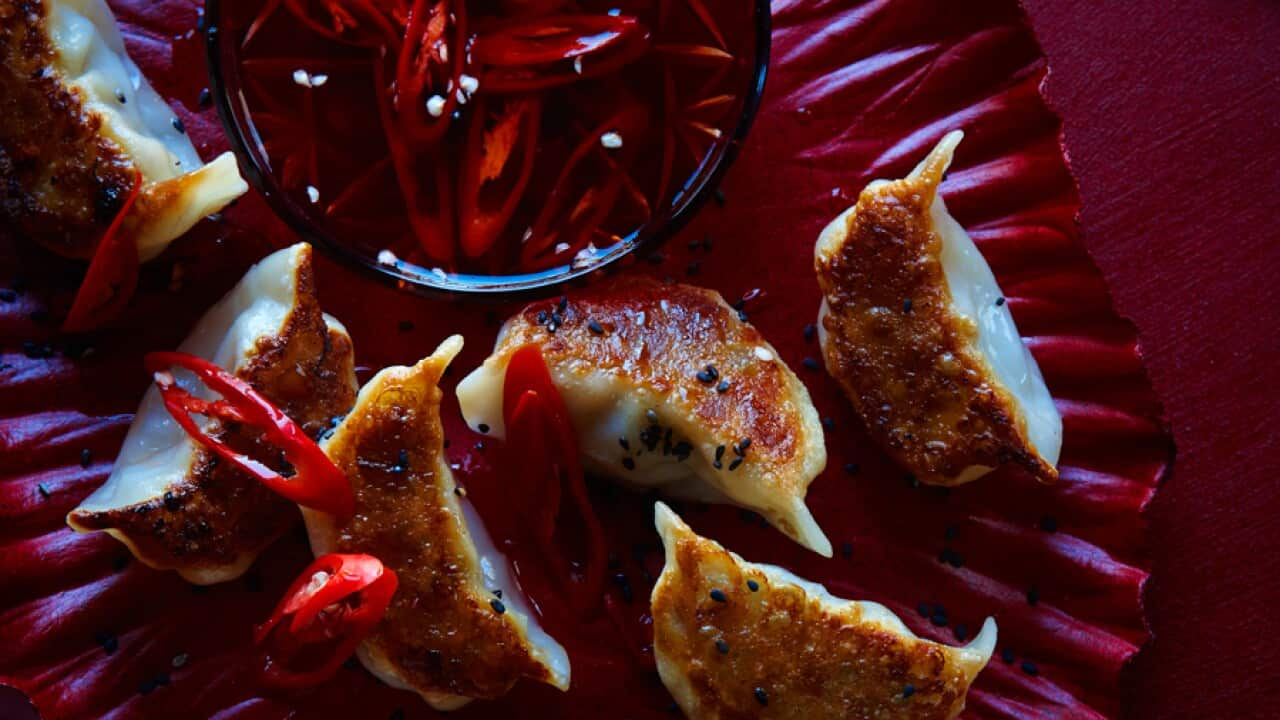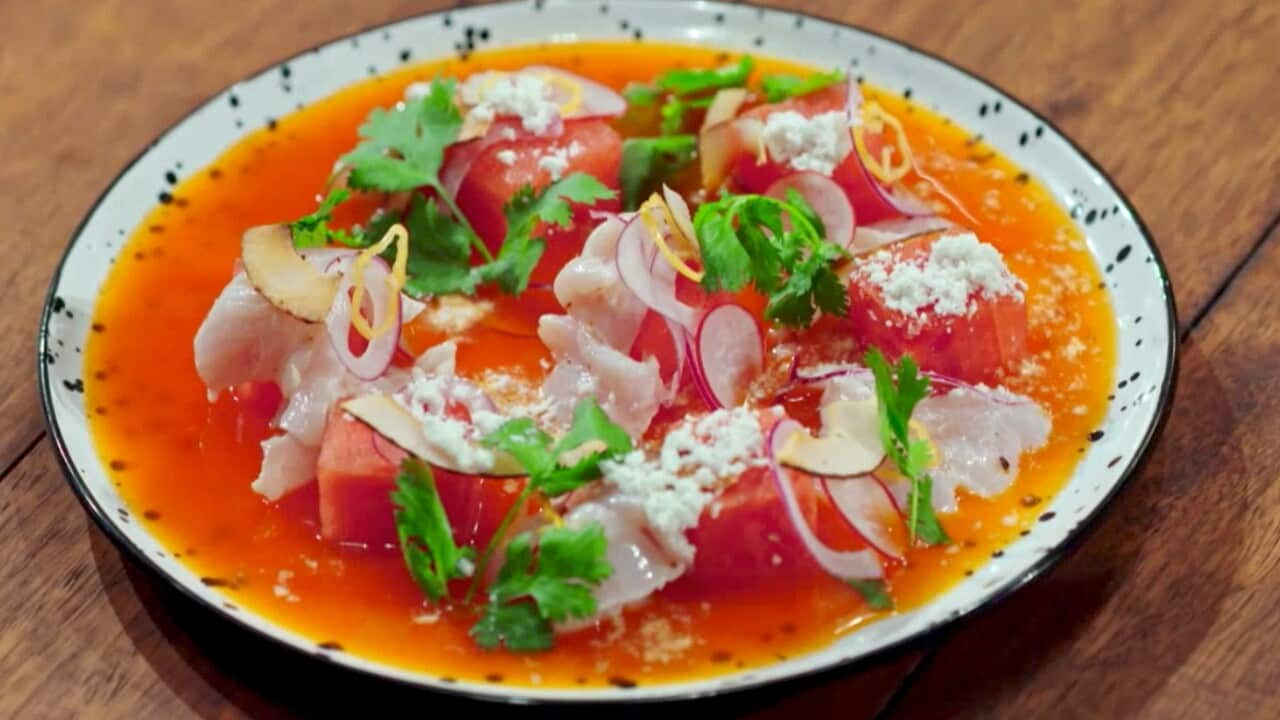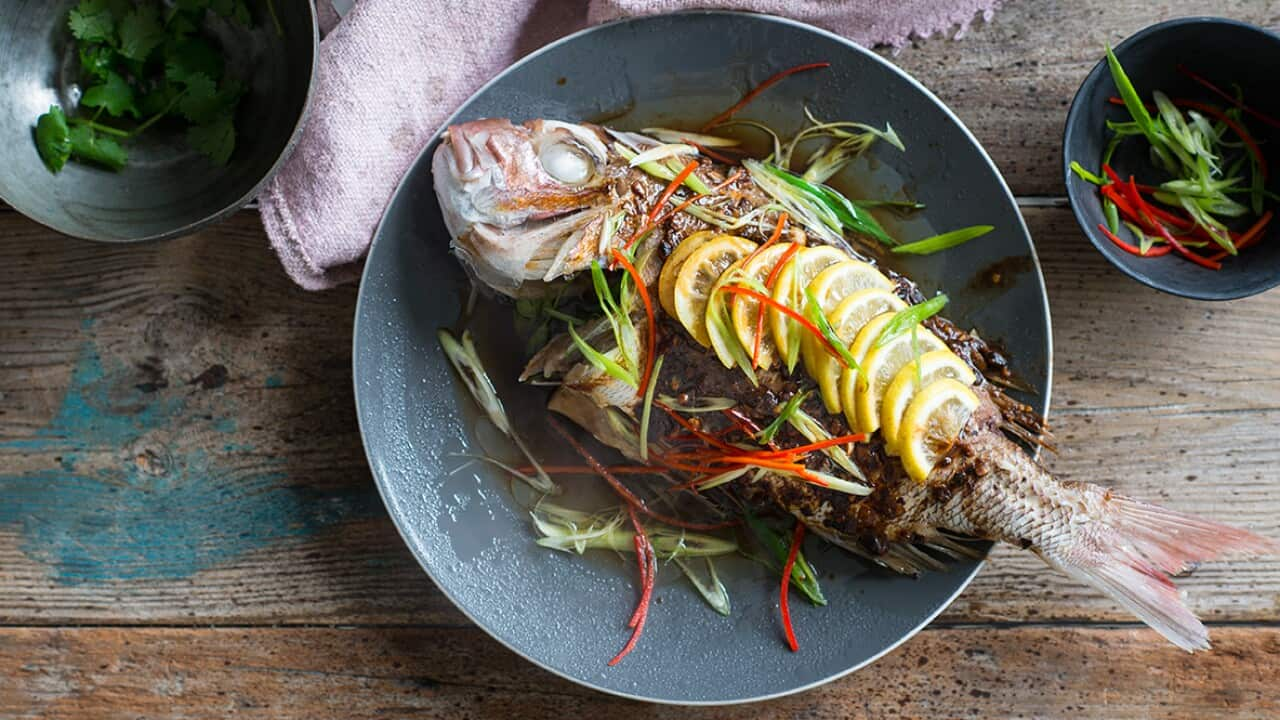--- Celebrate Lunar New Year with our curated collection of food shows and more, streaming free ---
Lunar New Year is a 15-day celebration that has as many variations of customs and rituals as there are families that celebrate it. But the goal is universal: to start the year off right by doing everything you can to nudge Lady Luck in your favour. This hope for a good year ahead is, of course, also expressed through food: every dish on the table is meant to have meaning and to bring some sort of wish for the future. Even your standard bowl of rice means something - you're supposed to go for seconds (no matter how small the serving) because it signifies that your rice bowl will always be "topped up" for the year ahead.
So get on your eating pants - here are our must-have dishes to celebrate this Lunar New Year.
Something to start with
These bean curd rolls are a popular snack during Chinese New Year celebrations. But rather than the rolls themselves signifying good fortune, it's the sum of its parts that actually makes the eater lucky. Filled with pork (signifying wealth), water chestnuts and leek (signifying intelligence), they’re delicious served with a cold beer. (Ngoh hiang. Hokkien spring rolls)

Fried pork rolls in bean curd skin (lor bak)
Fried, steamed or boiled, we love dumplings because they're little nuggets just bursting with flavour. These bring the eater prosperity through their shape - the half-moons resemble gold and silver ingots from days of old. Probably the most delicious you'll come to actually eating currency.

Pork and prawn potstickers Source: China Squirrel
Getting to the real meat of the matter...
The practice of having a type of meat (or three!) at the table stems from humble peasant roots. Back in the day, most people couldn't really afford to have meat at every meal, so meat dishes were scarce and sacred. Pork does usually reign supreme at the Chinese table, but poultry and fish all have their special roles to play too. No discrimination here!
In parts of Southeast Asia, this cut of pork rib is called "king spare ribs". The word for king (Wong), sounds remarkably similar to the word for prosper (see the theme, here?), which makes this a fantastic dish for business people to eat.
This particular recipe is a speciality of the old canal town of Wuxi, these chunky pork ribs are clothed in a gorgeous, aromatic gravy with a bit of the sweetness for which the local cooking is renowned. According to local lore, this particular recipe originated in the Nanchan Buddhist Temple. The gist of the story is that during the Southern Song dynasty, a visiting monk called Jigong gave the owner of a local cooked-meat shop some invaluable tips on the art of stewing meat (somewhat curiously, since Chinese Buddhist monks are normally vegetarians). Jigong cooked his meat slowly, overnight, in one of the temple’s incense burners, making all the young monks ‘drool with greed’, and the shop owner adopted his method.

Wuxi meaty pork ribs (wu xi rou gu tou) Source: Bloomsbury
A crispy roasted pork belly is a staple at the Lunar New Year table - after all, who can resist pork crackling in times of celebration? With the right method, this one's not hard to recreate at home, and if you have leftovers (big if), then you can also repurpose it to cheat a . Simply chop it up the next day, and fry it up with the sticky sauce.

Crispy roast pork belly Source: Brett Stevens
Cooking a whole chicken for Lunar New Year symbolises prosperity, wholeness and the togetherness of family. Our recipe starts with 'white cooked chicken’ - one that has been poached and allowed to finish its cooking by standing in a hot shaoxing wine, ginger, garlic and shallot stock, it is then drained, dried and deep-fried to crisp up the skin.

Crispy skin chicken with five-spice salt and sweet vinegar dressing Source: Petrina Tinslay
This Cantonese dish is traditionally served the day before the New Year. Yip Choi Khall’s has been cooking and perfecting her version of the dish for over 50 years now. Her choice of treasures for the stuffing beautifully complement the succulent duck and addition of fat choi (which incidentally, sounds like the phrase for "striking it rich"). Browning the duck before steaming seals the bird, ensuring all the flavours remain in the duck during the steaming process.

Eight treasure duck Source: Adam Liaw
If cooking a whole bird is not up your alley, then a modern solution is to take pieces, like duck breasts, and serve that up instead. This version features breasts that have been rubbed in a fennel salt and smoked over jasmine tea, and served alongside a sweet-salty-tart fresh cherry sauce.

Tea-smoked duck with Chinese pancakes and cherry sauce Source: China Squirrel
The word for fish in Chinese is "yu", which also sounds like the word for excess. The idea is that by eating fish at the beginning of the year, you'll hopefully have more than you need in the time that follows. This recipe looks impressive on the table but takes very little effort to create. It's designed to be served as part of a banquet or shared meal.

Whole braised fish with spring onion blanket
Created in Southeast Asia in the 1960s, this raw fish salad has sparked many an ownership debate between Singapore and Malaysia (think pavlova, but with different countries). Traditionally eaten on the seventh day of Lunar New Year (also known as the day humans were created), each ingredient on this colourful platter of shredded vegetables, pickled ginger and salmon garnished with a tasty sauce is meant to bring money, happiness and fulfilment to the eater.

Prosperity toss (yee sang)
READ MORE

Fish pie with mashed potato crust
Shellfishing for compliments...
As much as different types of meat are required at the Lunar new year table, there's a special place set aside for prawns at a Cantonese feast. The word for prawns in Cantonese is "ha", and the idea is that eating prawns will bring you laughter and happiness. Ha-ha, geddit?
Traditionally, this Fujian dish from the Qing Dynasty comprises up to 30 ingredients, including chicken, ham, taro, mushrooms and shark’s fin. Our recipe features more accessible ingredients while maintaining a high-protein hotpot. The origins of this dish’s name are debatable. One story describes how the meal’s rich aroma could tempt even Buddha to stop meditating and jump over a wall to find it.

Hotpot (Buddha jumps over the wall) Source: SBS food
Since this is a time for feasting and excess, we just had to include a recipe that requires deep frying. Chilli and garlic give these prawn morsels a flavour kick that'll keep you coming back for more!

Sichuan salt and pepper king prawns with wok-toasted chilli and garlic Source: New Holland
There is just one rule with this recipe: please PLEASE use a good quality XO; this spicy seafood sauce from Hong Kong is easily purchased... but not all commercial XOs are born equal. As a guide, the more expensive ones tend to be better and, if in doubt, just ask your local friendly Asian grocer. This recipe also has bonus points: it includes noodles! (More on that below.)

Crisp noodle cake with XO prawn stir-fry
The most universal Asian dish to use up leftovers: fried rice! One of the first dishes that are taught to young adults, this quick dish uses leftover rice with any leftover protein you might have. Substitute the prawns for barbecued pork or duck if preferred.

Fried rice with prawns Source: Alan Benson
Because you need to have balance in your life, too.
Rice cakes are called "nian gao" in Chinese, which although loosely translated to mean "new year (rice) cake", also sounds similar to "new year high". As in, "may you reach new heights in the new year". In this recipe, the famous Shanghai rice cake gets a twist with the addition of shredded pork. It’s a simple dish to prepare and a great savoury snack served with a glass of beer or orange juice.

Jacky’s Shanghai fried rice cake Source: SBS Food
Noodles are eaten because it is believed that the long strands represent a long life. This recipe is said to have been invented by a street vendor near the City God Temple in Shanghai, and features a combination of oil infused with the fragrance of spring onion and dried shrimps and the umami savouriness of soy sauce is irresistible, however simple it sounds.

Shanghai noodles with dried shrimps and spring onion oil Source: Bloomsbury
If you like your noodles with a little more pizazz, you can try making wonton mee. This dish combines many "good luck foods" - wontons are dumplings, char siew is made from pork, and well, it's all served on noodles! Ticking all the boxes, in the most delicious way.

Dry wonton noodles with char sui and choy sum Source: Alan Benson
If you like something with a little more kick, try this simplified version of a heritage Nonya dish from Penang. Purists would insist on charcoal-roasting the belacan, hand pounding chillies and garlic in a mortar, and slow-frying the kerisik (the coconut-based garnish that’s spiked with dried shrimp and galangal) over a flame. In Penang, they’d use calamansi lime juice too and some chopped torch ginger flower as a finishing touch, but these ingredients are hard to get. Despite the modifications here, this dish is still insanely good.

Spicy rice noodle salad
Five a day? You mean five lucky things a day!
This vegetarian dish is traditionally served on the first day of the Chinese New Year, where some people decide to have a vegetarian meal (good for the karma to not kill any living creature with two eyes). The inclusion of red fermented bean curd lends a salty, pungent flavour to the sauce. This ingredient is available from Asian food shops.

Vegetarian feast (Buddha’s feast)
Eggplant, to some groups of the Chinese diaspora, represents promotion at work. This Shanghainese appetiser is absurdly easy to make and wondrously satisfying. Steaming brings out a gentle, unfamiliar side to a vegetable that is more commonly fried, baked or grilled, and, simple as they are, the seasonings taste sublime. Use Mediterranean aubergines or, if you can find them, the slender purple Chinese variety.

Cool steamed aubergine with a garlicky dressing (liang ban qie zi) Source: Bloomsbury
Tofu is another cornerstone ingredient of Chinese cuisine, and to some, it represents beauty by blessing the eater with a silky smooth and fair complexion, just like the silky smooth cubes on the plate. This recipe even has the bonus of being garnished with spring onions (cong), which represents intelligence.

Deep fried tofu Source: Sharyn Cairns
Despite the name, this Singaporean street food favourite doesn’t contain any carrots at all. Instead, white radish makes the base of this comforting savoury cake which is crisp on the outside while soft and chewy in the centre. The radish in this case (chai tow) translates to "vegetable head", which we eat to get a "head start" in the new year.

Fried carrot cake (chai tow kway) Source: Sharyn Cairns
Beyond the fact that dessert is delicious, the Chinese believe strongly in something sweet to end the meal with, because strong beginnings also need sweet and harmonious endings. Even when you're completely stuffed, there is an expectation to have at least a bite, to remove clashing aftertastes in your mouth (and in life!).
These little pretty purses called tang-yuan, meaning ‘soup circles’, are a wildly beloved Chinese dessert and are very popular, if not mandatory, at all major celebratory events because the circles represent reunion and the whole-ness of the family. Each ball is a mouthful of complimenting textures and flavours – chewy and runny, sweet and slightly salty, intensely nutty and rich – balanced with the subtle bitterness and fragrance from lightly honey-sweetened green tea.

Peanut butter sticky rice balls in green tea Source: Mandy Lee
Fermented glutinous rice dumplings are a very popular dessert with a long history in China. They are enjoyed on special occasions, like Chinese New Year, and are a "must-order" at restaurants. They are also said to have medicinal properties, promoting blood circulation for women, and even slowing the ageing process! This dessert doesn't taste overly sweet and is very easy to make.

Fermented glutinous rice dumpling Source: Alan Benson
These cakes are called nan gua bing, which literally translates to pumpkin cakes, but this recipe uses sweet potato instead. Pumpkins in Chinese fall under a loose melon category, which symbolises fertility. Often offered to women, it is hoped that these cakes will bless the eater with many sons.

Mochi cakes Source: Betty Liu
You're probably thinking, "Please! My stomach can't take any more food. I've eaten too much". Well, that's where we start sending you home with food. After all, you might get hungry in an hour or two, and what kind of hosts would we be if we didn't make sure you're fed?
These delicate little coconut wafers are a staple of Chinese New Year because they would always be offered as a snack during the practice of ‘open house’, where friends and relatives could visit each other unannounced over the many days of this celebration. Sweet and crispy, these can also be rolled into cigar shapes.

Coconut love letters Source: Poh & Co.
This fascinating Indonesian cake is not difficult to make, but you do need patience for the special cooking method. The layers, each hardly thicker than a wafer biscuit, are baked and then grilled one at a time. Be prepared to hover over the oven for a couple of hours preferably when the weather is cold enough to make this a comfortable occupation! Some people prefer a light-textured cake, while others prefer a pudding-like texture that is richer and sweeter. The cake is served in very small, thin slices as it is so rich - perfect for serving up to unexpected guests!

Thousand-layer cake (lapis legit)









